Case Study: Employee Motivation Strategies at Suit and Thai Restaurant
VerifiedAdded on 2020/04/13
|7
|2396
|1053
Case Study
AI Summary
This case study examines the organizational behavior of Wazza Gold, a dishwasher at Bruce Fox's restaurant, 'Suit and Thai.' The study highlights how Fox employed various motivational strategies, including goal-setting, self-efficacy, expectancy, and intrinsic rewards theories, to improve Wazza's performance. Initially slow and inefficient, Wazza's work ethic transformed when Fox implemented a daily pay system and a performance board. The analysis delves into the specifics of each theory, illustrating how they were applied to boost Wazza's productivity and job satisfaction. The case also suggests additional strategies for further improvement, such as job enrichment, offering time off, supporting Wazza's education, and providing food rewards. The conclusion emphasizes the impact of effective employee motivation techniques in the workplace, transforming Wazza's performance from poor to perfection. This case serves as an excellent example of how simple tools can be used to enhance employee motivation and performance.
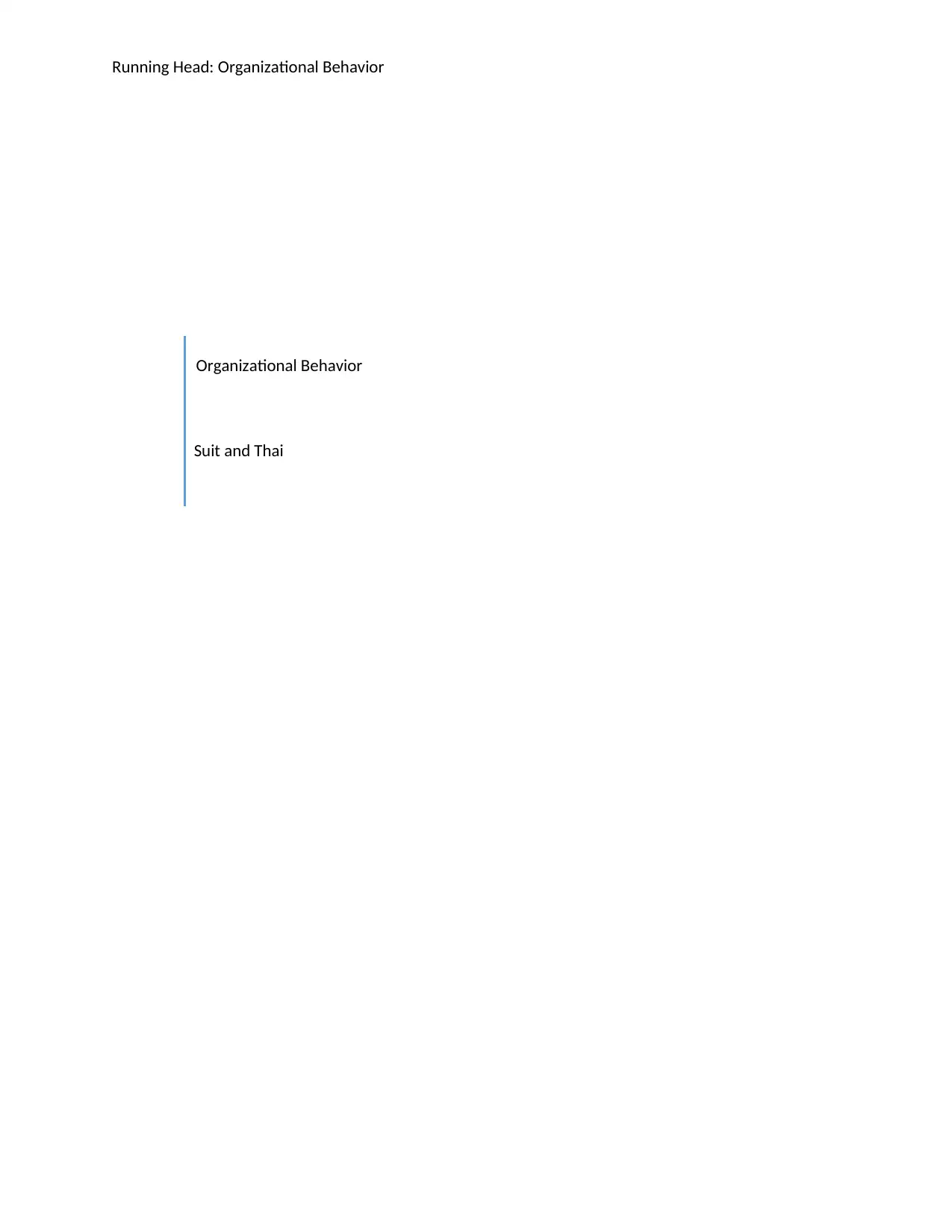
Running Head: Organizational Behavior
Organizational Behavior
Suit and Thai
Organizational Behavior
Suit and Thai
Paraphrase This Document
Need a fresh take? Get an instant paraphrase of this document with our AI Paraphraser
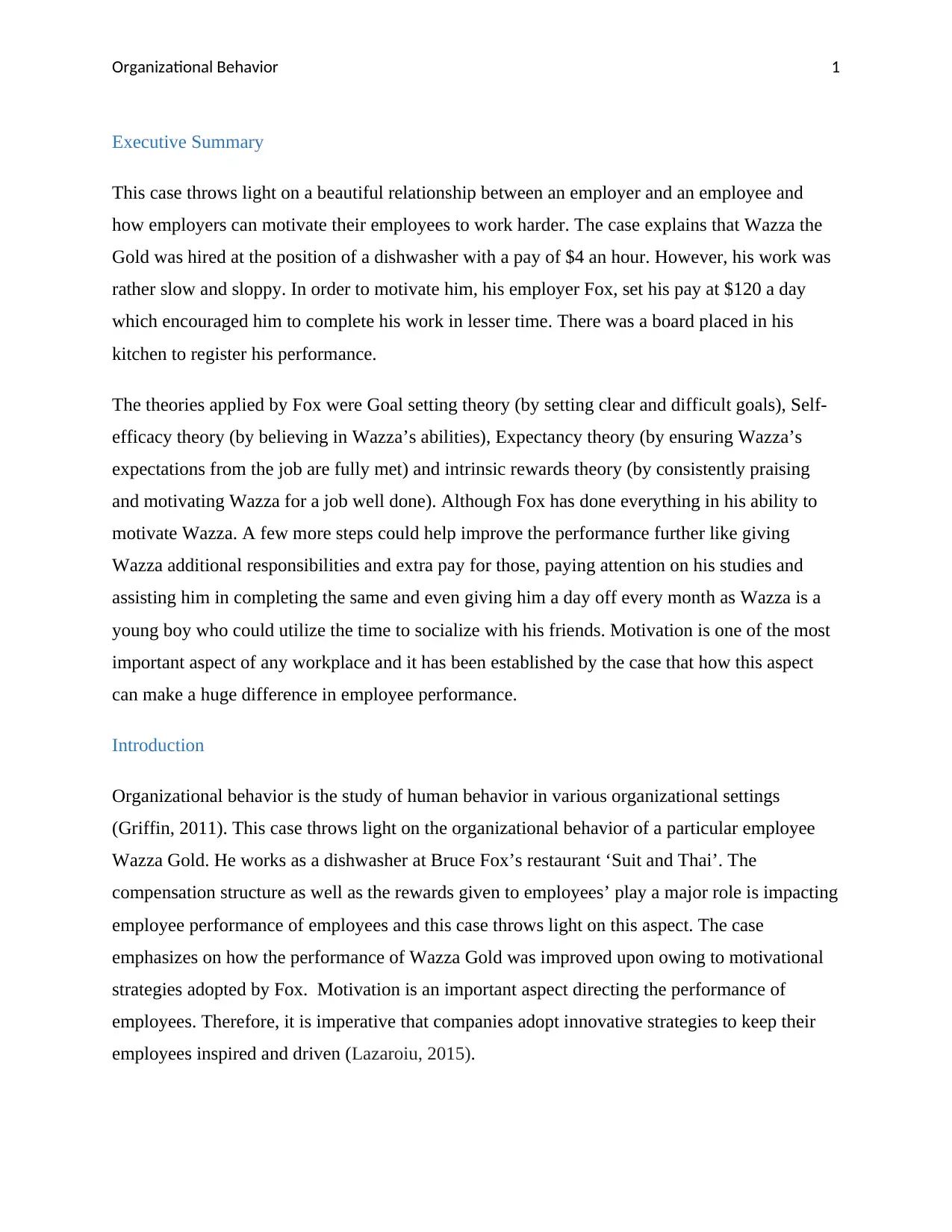
Organizational Behavior 1
Executive Summary
This case throws light on a beautiful relationship between an employer and an employee and
how employers can motivate their employees to work harder. The case explains that Wazza the
Gold was hired at the position of a dishwasher with a pay of $4 an hour. However, his work was
rather slow and sloppy. In order to motivate him, his employer Fox, set his pay at $120 a day
which encouraged him to complete his work in lesser time. There was a board placed in his
kitchen to register his performance.
The theories applied by Fox were Goal setting theory (by setting clear and difficult goals), Self-
efficacy theory (by believing in Wazza’s abilities), Expectancy theory (by ensuring Wazza’s
expectations from the job are fully met) and intrinsic rewards theory (by consistently praising
and motivating Wazza for a job well done). Although Fox has done everything in his ability to
motivate Wazza. A few more steps could help improve the performance further like giving
Wazza additional responsibilities and extra pay for those, paying attention on his studies and
assisting him in completing the same and even giving him a day off every month as Wazza is a
young boy who could utilize the time to socialize with his friends. Motivation is one of the most
important aspect of any workplace and it has been established by the case that how this aspect
can make a huge difference in employee performance.
Introduction
Organizational behavior is the study of human behavior in various organizational settings
(Griffin, 2011). This case throws light on the organizational behavior of a particular employee
Wazza Gold. He works as a dishwasher at Bruce Fox’s restaurant ‘Suit and Thai’. The
compensation structure as well as the rewards given to employees’ play a major role is impacting
employee performance of employees and this case throws light on this aspect. The case
emphasizes on how the performance of Wazza Gold was improved upon owing to motivational
strategies adopted by Fox. Motivation is an important aspect directing the performance of
employees. Therefore, it is imperative that companies adopt innovative strategies to keep their
employees inspired and driven (Lazaroiu, 2015).
Executive Summary
This case throws light on a beautiful relationship between an employer and an employee and
how employers can motivate their employees to work harder. The case explains that Wazza the
Gold was hired at the position of a dishwasher with a pay of $4 an hour. However, his work was
rather slow and sloppy. In order to motivate him, his employer Fox, set his pay at $120 a day
which encouraged him to complete his work in lesser time. There was a board placed in his
kitchen to register his performance.
The theories applied by Fox were Goal setting theory (by setting clear and difficult goals), Self-
efficacy theory (by believing in Wazza’s abilities), Expectancy theory (by ensuring Wazza’s
expectations from the job are fully met) and intrinsic rewards theory (by consistently praising
and motivating Wazza for a job well done). Although Fox has done everything in his ability to
motivate Wazza. A few more steps could help improve the performance further like giving
Wazza additional responsibilities and extra pay for those, paying attention on his studies and
assisting him in completing the same and even giving him a day off every month as Wazza is a
young boy who could utilize the time to socialize with his friends. Motivation is one of the most
important aspect of any workplace and it has been established by the case that how this aspect
can make a huge difference in employee performance.
Introduction
Organizational behavior is the study of human behavior in various organizational settings
(Griffin, 2011). This case throws light on the organizational behavior of a particular employee
Wazza Gold. He works as a dishwasher at Bruce Fox’s restaurant ‘Suit and Thai’. The
compensation structure as well as the rewards given to employees’ play a major role is impacting
employee performance of employees and this case throws light on this aspect. The case
emphasizes on how the performance of Wazza Gold was improved upon owing to motivational
strategies adopted by Fox. Motivation is an important aspect directing the performance of
employees. Therefore, it is imperative that companies adopt innovative strategies to keep their
employees inspired and driven (Lazaroiu, 2015).
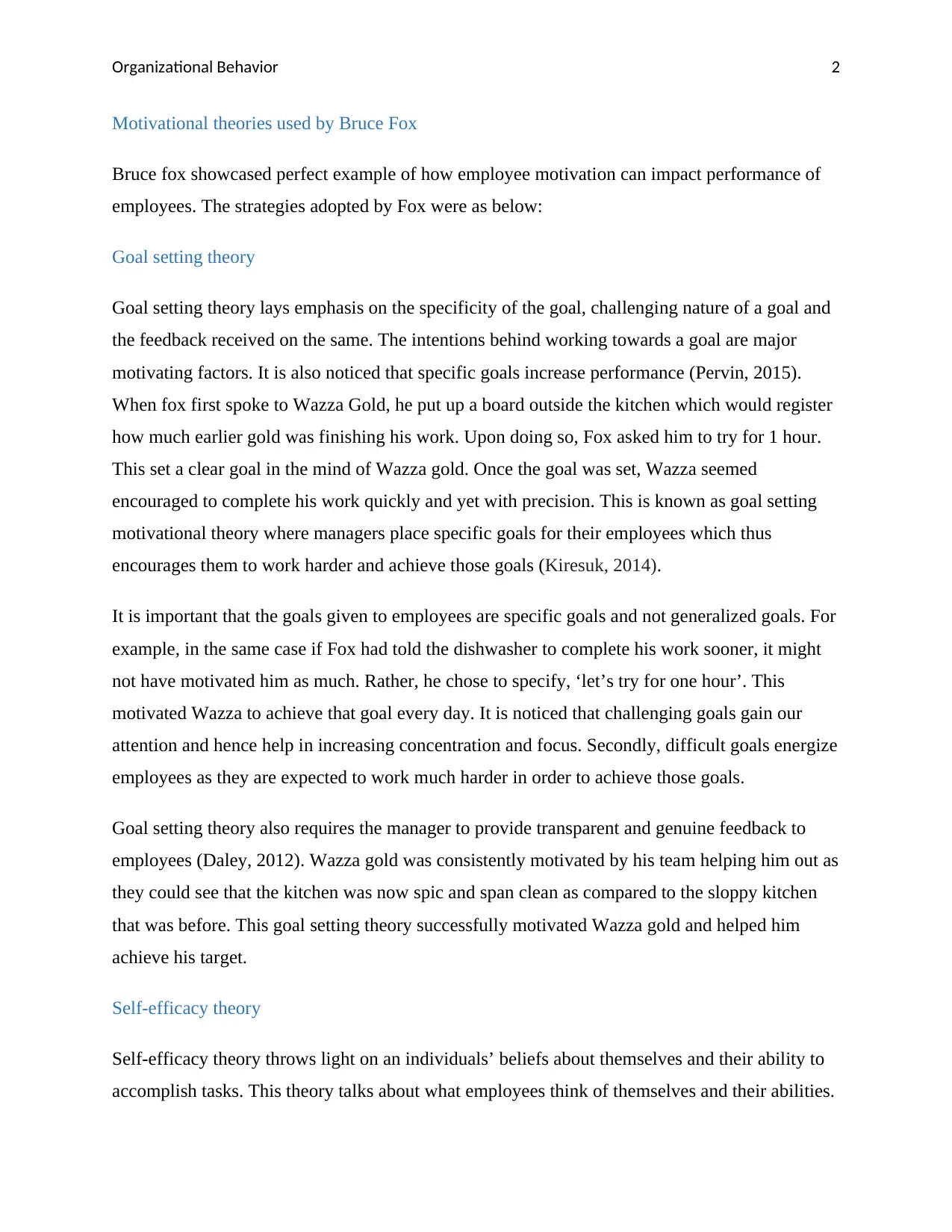
Organizational Behavior 2
Motivational theories used by Bruce Fox
Bruce fox showcased perfect example of how employee motivation can impact performance of
employees. The strategies adopted by Fox were as below:
Goal setting theory
Goal setting theory lays emphasis on the specificity of the goal, challenging nature of a goal and
the feedback received on the same. The intentions behind working towards a goal are major
motivating factors. It is also noticed that specific goals increase performance (Pervin, 2015).
When fox first spoke to Wazza Gold, he put up a board outside the kitchen which would register
how much earlier gold was finishing his work. Upon doing so, Fox asked him to try for 1 hour.
This set a clear goal in the mind of Wazza gold. Once the goal was set, Wazza seemed
encouraged to complete his work quickly and yet with precision. This is known as goal setting
motivational theory where managers place specific goals for their employees which thus
encourages them to work harder and achieve those goals (Kiresuk, 2014).
It is important that the goals given to employees are specific goals and not generalized goals. For
example, in the same case if Fox had told the dishwasher to complete his work sooner, it might
not have motivated him as much. Rather, he chose to specify, ‘let’s try for one hour’. This
motivated Wazza to achieve that goal every day. It is noticed that challenging goals gain our
attention and hence help in increasing concentration and focus. Secondly, difficult goals energize
employees as they are expected to work much harder in order to achieve those goals.
Goal setting theory also requires the manager to provide transparent and genuine feedback to
employees (Daley, 2012). Wazza gold was consistently motivated by his team helping him out as
they could see that the kitchen was now spic and span clean as compared to the sloppy kitchen
that was before. This goal setting theory successfully motivated Wazza gold and helped him
achieve his target.
Self-efficacy theory
Self-efficacy theory throws light on an individuals’ beliefs about themselves and their ability to
accomplish tasks. This theory talks about what employees think of themselves and their abilities.
Motivational theories used by Bruce Fox
Bruce fox showcased perfect example of how employee motivation can impact performance of
employees. The strategies adopted by Fox were as below:
Goal setting theory
Goal setting theory lays emphasis on the specificity of the goal, challenging nature of a goal and
the feedback received on the same. The intentions behind working towards a goal are major
motivating factors. It is also noticed that specific goals increase performance (Pervin, 2015).
When fox first spoke to Wazza Gold, he put up a board outside the kitchen which would register
how much earlier gold was finishing his work. Upon doing so, Fox asked him to try for 1 hour.
This set a clear goal in the mind of Wazza gold. Once the goal was set, Wazza seemed
encouraged to complete his work quickly and yet with precision. This is known as goal setting
motivational theory where managers place specific goals for their employees which thus
encourages them to work harder and achieve those goals (Kiresuk, 2014).
It is important that the goals given to employees are specific goals and not generalized goals. For
example, in the same case if Fox had told the dishwasher to complete his work sooner, it might
not have motivated him as much. Rather, he chose to specify, ‘let’s try for one hour’. This
motivated Wazza to achieve that goal every day. It is noticed that challenging goals gain our
attention and hence help in increasing concentration and focus. Secondly, difficult goals energize
employees as they are expected to work much harder in order to achieve those goals.
Goal setting theory also requires the manager to provide transparent and genuine feedback to
employees (Daley, 2012). Wazza gold was consistently motivated by his team helping him out as
they could see that the kitchen was now spic and span clean as compared to the sloppy kitchen
that was before. This goal setting theory successfully motivated Wazza gold and helped him
achieve his target.
Self-efficacy theory
Self-efficacy theory throws light on an individuals’ beliefs about themselves and their ability to
accomplish tasks. This theory talks about what employees think of themselves and their abilities.
⊘ This is a preview!⊘
Do you want full access?
Subscribe today to unlock all pages.

Trusted by 1+ million students worldwide
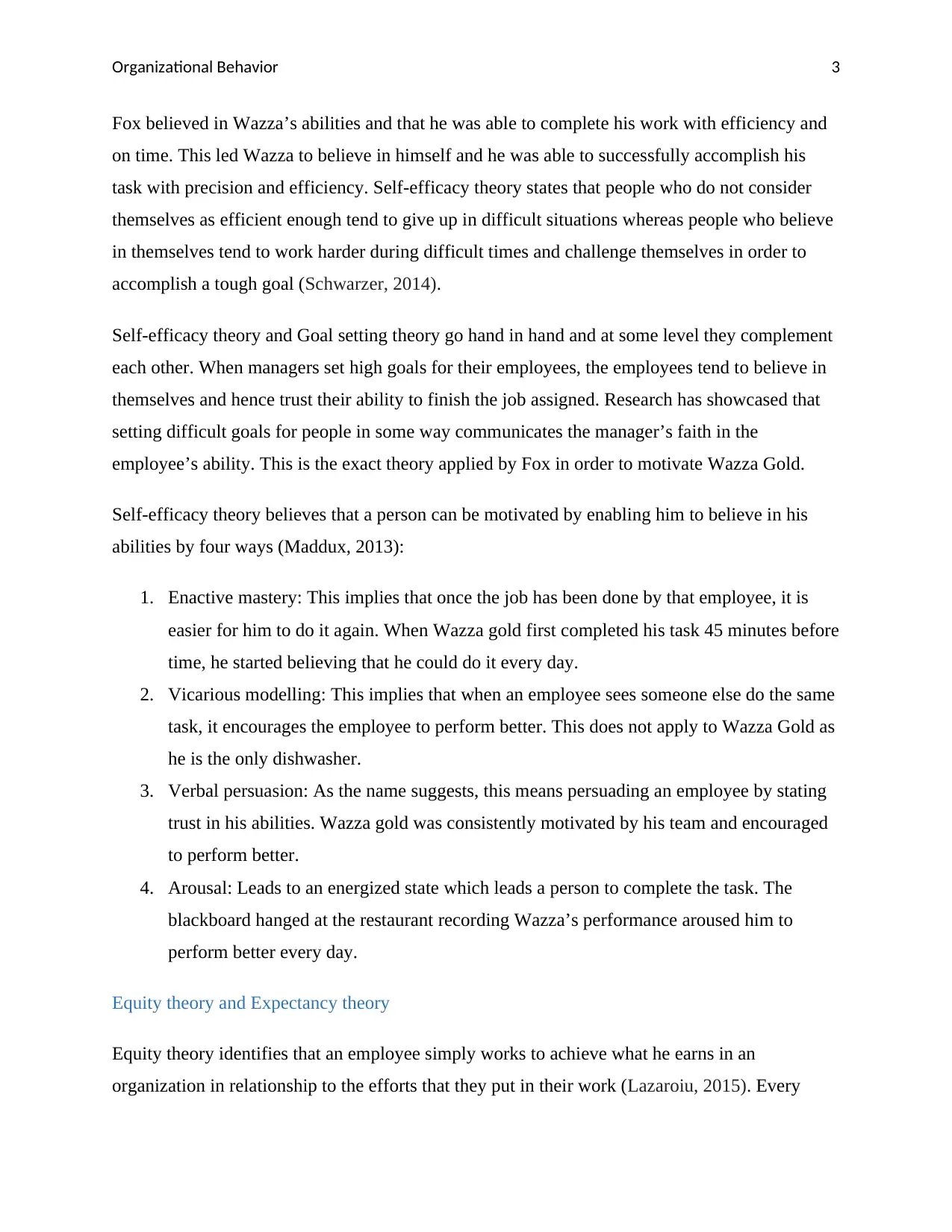
Organizational Behavior 3
Fox believed in Wazza’s abilities and that he was able to complete his work with efficiency and
on time. This led Wazza to believe in himself and he was able to successfully accomplish his
task with precision and efficiency. Self-efficacy theory states that people who do not consider
themselves as efficient enough tend to give up in difficult situations whereas people who believe
in themselves tend to work harder during difficult times and challenge themselves in order to
accomplish a tough goal (Schwarzer, 2014).
Self-efficacy theory and Goal setting theory go hand in hand and at some level they complement
each other. When managers set high goals for their employees, the employees tend to believe in
themselves and hence trust their ability to finish the job assigned. Research has showcased that
setting difficult goals for people in some way communicates the manager’s faith in the
employee’s ability. This is the exact theory applied by Fox in order to motivate Wazza Gold.
Self-efficacy theory believes that a person can be motivated by enabling him to believe in his
abilities by four ways (Maddux, 2013):
1. Enactive mastery: This implies that once the job has been done by that employee, it is
easier for him to do it again. When Wazza gold first completed his task 45 minutes before
time, he started believing that he could do it every day.
2. Vicarious modelling: This implies that when an employee sees someone else do the same
task, it encourages the employee to perform better. This does not apply to Wazza Gold as
he is the only dishwasher.
3. Verbal persuasion: As the name suggests, this means persuading an employee by stating
trust in his abilities. Wazza gold was consistently motivated by his team and encouraged
to perform better.
4. Arousal: Leads to an energized state which leads a person to complete the task. The
blackboard hanged at the restaurant recording Wazza’s performance aroused him to
perform better every day.
Equity theory and Expectancy theory
Equity theory identifies that an employee simply works to achieve what he earns in an
organization in relationship to the efforts that they put in their work (Lazaroiu, 2015). Every
Fox believed in Wazza’s abilities and that he was able to complete his work with efficiency and
on time. This led Wazza to believe in himself and he was able to successfully accomplish his
task with precision and efficiency. Self-efficacy theory states that people who do not consider
themselves as efficient enough tend to give up in difficult situations whereas people who believe
in themselves tend to work harder during difficult times and challenge themselves in order to
accomplish a tough goal (Schwarzer, 2014).
Self-efficacy theory and Goal setting theory go hand in hand and at some level they complement
each other. When managers set high goals for their employees, the employees tend to believe in
themselves and hence trust their ability to finish the job assigned. Research has showcased that
setting difficult goals for people in some way communicates the manager’s faith in the
employee’s ability. This is the exact theory applied by Fox in order to motivate Wazza Gold.
Self-efficacy theory believes that a person can be motivated by enabling him to believe in his
abilities by four ways (Maddux, 2013):
1. Enactive mastery: This implies that once the job has been done by that employee, it is
easier for him to do it again. When Wazza gold first completed his task 45 minutes before
time, he started believing that he could do it every day.
2. Vicarious modelling: This implies that when an employee sees someone else do the same
task, it encourages the employee to perform better. This does not apply to Wazza Gold as
he is the only dishwasher.
3. Verbal persuasion: As the name suggests, this means persuading an employee by stating
trust in his abilities. Wazza gold was consistently motivated by his team and encouraged
to perform better.
4. Arousal: Leads to an energized state which leads a person to complete the task. The
blackboard hanged at the restaurant recording Wazza’s performance aroused him to
perform better every day.
Equity theory and Expectancy theory
Equity theory identifies that an employee simply works to achieve what he earns in an
organization in relationship to the efforts that they put in their work (Lazaroiu, 2015). Every
Paraphrase This Document
Need a fresh take? Get an instant paraphrase of this document with our AI Paraphraser
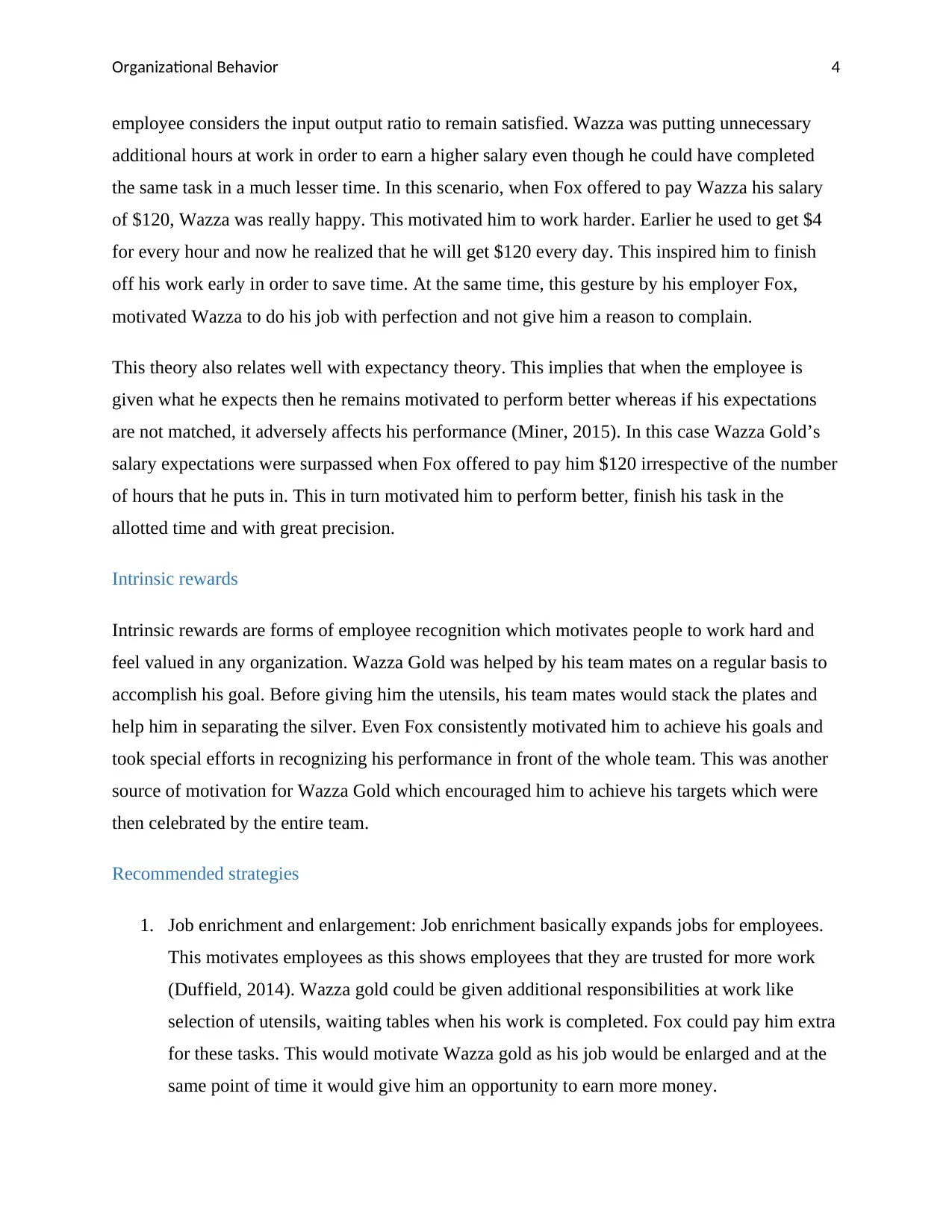
Organizational Behavior 4
employee considers the input output ratio to remain satisfied. Wazza was putting unnecessary
additional hours at work in order to earn a higher salary even though he could have completed
the same task in a much lesser time. In this scenario, when Fox offered to pay Wazza his salary
of $120, Wazza was really happy. This motivated him to work harder. Earlier he used to get $4
for every hour and now he realized that he will get $120 every day. This inspired him to finish
off his work early in order to save time. At the same time, this gesture by his employer Fox,
motivated Wazza to do his job with perfection and not give him a reason to complain.
This theory also relates well with expectancy theory. This implies that when the employee is
given what he expects then he remains motivated to perform better whereas if his expectations
are not matched, it adversely affects his performance (Miner, 2015). In this case Wazza Gold’s
salary expectations were surpassed when Fox offered to pay him $120 irrespective of the number
of hours that he puts in. This in turn motivated him to perform better, finish his task in the
allotted time and with great precision.
Intrinsic rewards
Intrinsic rewards are forms of employee recognition which motivates people to work hard and
feel valued in any organization. Wazza Gold was helped by his team mates on a regular basis to
accomplish his goal. Before giving him the utensils, his team mates would stack the plates and
help him in separating the silver. Even Fox consistently motivated him to achieve his goals and
took special efforts in recognizing his performance in front of the whole team. This was another
source of motivation for Wazza Gold which encouraged him to achieve his targets which were
then celebrated by the entire team.
Recommended strategies
1. Job enrichment and enlargement: Job enrichment basically expands jobs for employees.
This motivates employees as this shows employees that they are trusted for more work
(Duffield, 2014). Wazza gold could be given additional responsibilities at work like
selection of utensils, waiting tables when his work is completed. Fox could pay him extra
for these tasks. This would motivate Wazza gold as his job would be enlarged and at the
same point of time it would give him an opportunity to earn more money.
employee considers the input output ratio to remain satisfied. Wazza was putting unnecessary
additional hours at work in order to earn a higher salary even though he could have completed
the same task in a much lesser time. In this scenario, when Fox offered to pay Wazza his salary
of $120, Wazza was really happy. This motivated him to work harder. Earlier he used to get $4
for every hour and now he realized that he will get $120 every day. This inspired him to finish
off his work early in order to save time. At the same time, this gesture by his employer Fox,
motivated Wazza to do his job with perfection and not give him a reason to complain.
This theory also relates well with expectancy theory. This implies that when the employee is
given what he expects then he remains motivated to perform better whereas if his expectations
are not matched, it adversely affects his performance (Miner, 2015). In this case Wazza Gold’s
salary expectations were surpassed when Fox offered to pay him $120 irrespective of the number
of hours that he puts in. This in turn motivated him to perform better, finish his task in the
allotted time and with great precision.
Intrinsic rewards
Intrinsic rewards are forms of employee recognition which motivates people to work hard and
feel valued in any organization. Wazza Gold was helped by his team mates on a regular basis to
accomplish his goal. Before giving him the utensils, his team mates would stack the plates and
help him in separating the silver. Even Fox consistently motivated him to achieve his goals and
took special efforts in recognizing his performance in front of the whole team. This was another
source of motivation for Wazza Gold which encouraged him to achieve his targets which were
then celebrated by the entire team.
Recommended strategies
1. Job enrichment and enlargement: Job enrichment basically expands jobs for employees.
This motivates employees as this shows employees that they are trusted for more work
(Duffield, 2014). Wazza gold could be given additional responsibilities at work like
selection of utensils, waiting tables when his work is completed. Fox could pay him extra
for these tasks. This would motivate Wazza gold as his job would be enlarged and at the
same point of time it would give him an opportunity to earn more money.
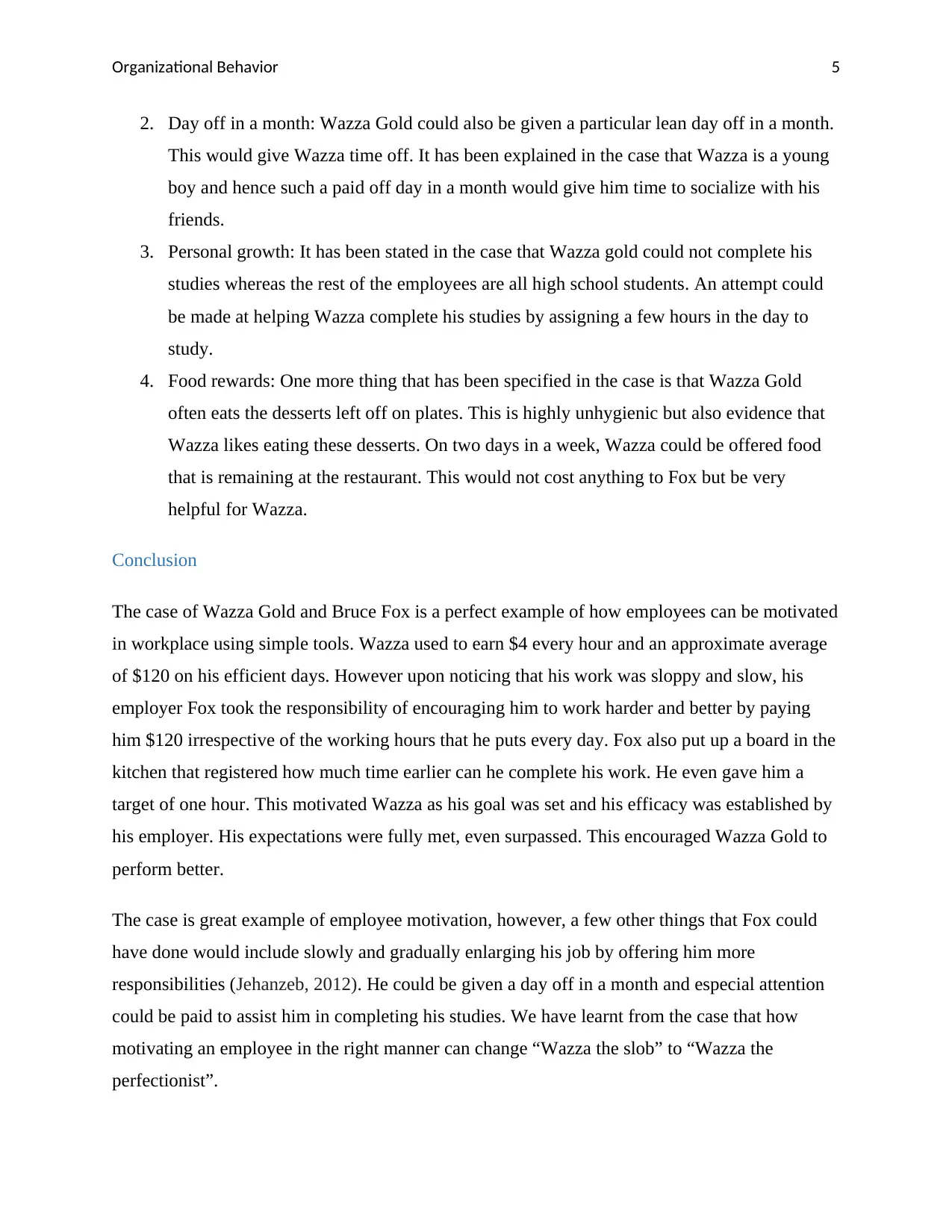
Organizational Behavior 5
2. Day off in a month: Wazza Gold could also be given a particular lean day off in a month.
This would give Wazza time off. It has been explained in the case that Wazza is a young
boy and hence such a paid off day in a month would give him time to socialize with his
friends.
3. Personal growth: It has been stated in the case that Wazza gold could not complete his
studies whereas the rest of the employees are all high school students. An attempt could
be made at helping Wazza complete his studies by assigning a few hours in the day to
study.
4. Food rewards: One more thing that has been specified in the case is that Wazza Gold
often eats the desserts left off on plates. This is highly unhygienic but also evidence that
Wazza likes eating these desserts. On two days in a week, Wazza could be offered food
that is remaining at the restaurant. This would not cost anything to Fox but be very
helpful for Wazza.
Conclusion
The case of Wazza Gold and Bruce Fox is a perfect example of how employees can be motivated
in workplace using simple tools. Wazza used to earn $4 every hour and an approximate average
of $120 on his efficient days. However upon noticing that his work was sloppy and slow, his
employer Fox took the responsibility of encouraging him to work harder and better by paying
him $120 irrespective of the working hours that he puts every day. Fox also put up a board in the
kitchen that registered how much time earlier can he complete his work. He even gave him a
target of one hour. This motivated Wazza as his goal was set and his efficacy was established by
his employer. His expectations were fully met, even surpassed. This encouraged Wazza Gold to
perform better.
The case is great example of employee motivation, however, a few other things that Fox could
have done would include slowly and gradually enlarging his job by offering him more
responsibilities (Jehanzeb, 2012). He could be given a day off in a month and especial attention
could be paid to assist him in completing his studies. We have learnt from the case that how
motivating an employee in the right manner can change “Wazza the slob” to “Wazza the
perfectionist”.
2. Day off in a month: Wazza Gold could also be given a particular lean day off in a month.
This would give Wazza time off. It has been explained in the case that Wazza is a young
boy and hence such a paid off day in a month would give him time to socialize with his
friends.
3. Personal growth: It has been stated in the case that Wazza gold could not complete his
studies whereas the rest of the employees are all high school students. An attempt could
be made at helping Wazza complete his studies by assigning a few hours in the day to
study.
4. Food rewards: One more thing that has been specified in the case is that Wazza Gold
often eats the desserts left off on plates. This is highly unhygienic but also evidence that
Wazza likes eating these desserts. On two days in a week, Wazza could be offered food
that is remaining at the restaurant. This would not cost anything to Fox but be very
helpful for Wazza.
Conclusion
The case of Wazza Gold and Bruce Fox is a perfect example of how employees can be motivated
in workplace using simple tools. Wazza used to earn $4 every hour and an approximate average
of $120 on his efficient days. However upon noticing that his work was sloppy and slow, his
employer Fox took the responsibility of encouraging him to work harder and better by paying
him $120 irrespective of the working hours that he puts every day. Fox also put up a board in the
kitchen that registered how much time earlier can he complete his work. He even gave him a
target of one hour. This motivated Wazza as his goal was set and his efficacy was established by
his employer. His expectations were fully met, even surpassed. This encouraged Wazza Gold to
perform better.
The case is great example of employee motivation, however, a few other things that Fox could
have done would include slowly and gradually enlarging his job by offering him more
responsibilities (Jehanzeb, 2012). He could be given a day off in a month and especial attention
could be paid to assist him in completing his studies. We have learnt from the case that how
motivating an employee in the right manner can change “Wazza the slob” to “Wazza the
perfectionist”.
⊘ This is a preview!⊘
Do you want full access?
Subscribe today to unlock all pages.

Trusted by 1+ million students worldwide
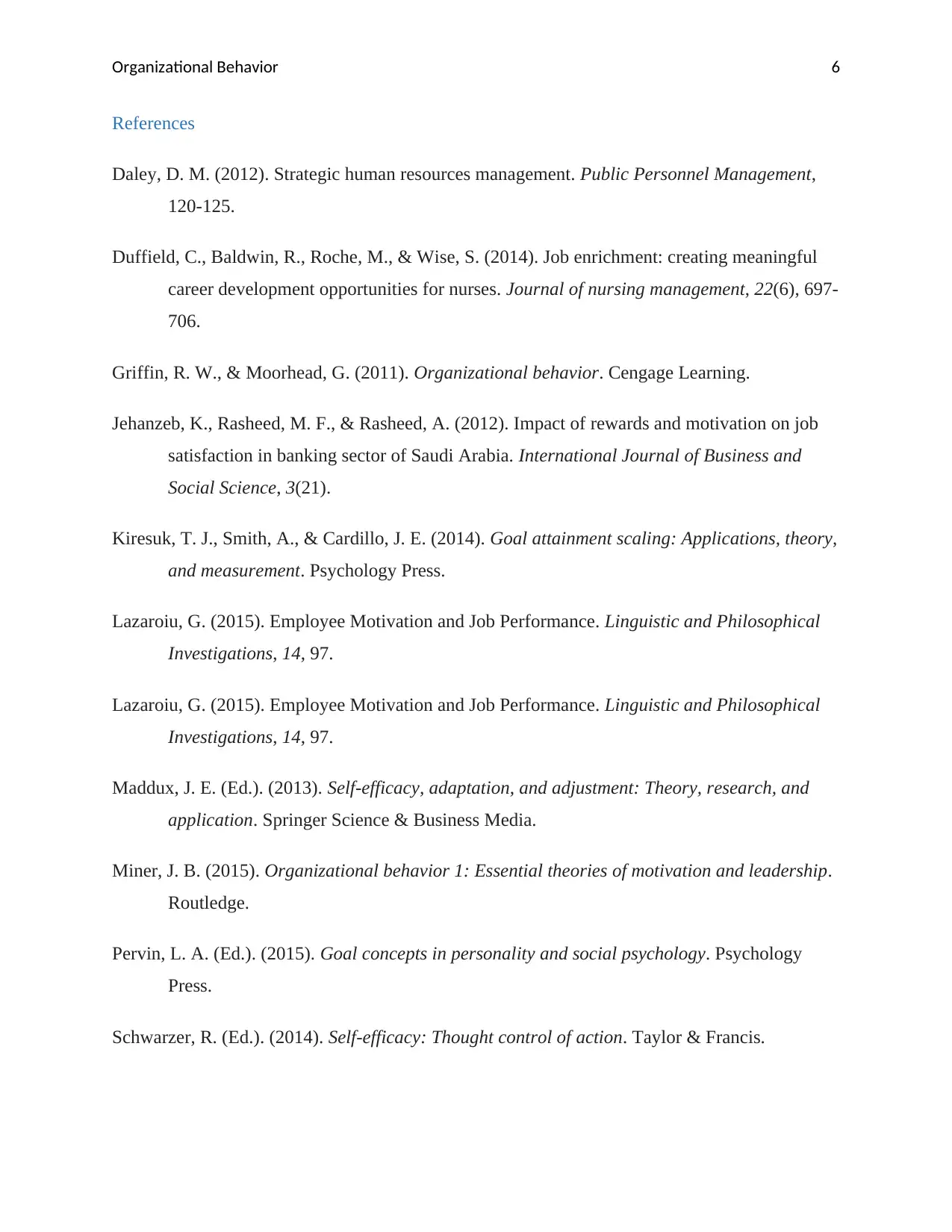
Organizational Behavior 6
References
Daley, D. M. (2012). Strategic human resources management. Public Personnel Management,
120-125.
Duffield, C., Baldwin, R., Roche, M., & Wise, S. (2014). Job enrichment: creating meaningful
career development opportunities for nurses. Journal of nursing management, 22(6), 697-
706.
Griffin, R. W., & Moorhead, G. (2011). Organizational behavior. Cengage Learning.
Jehanzeb, K., Rasheed, M. F., & Rasheed, A. (2012). Impact of rewards and motivation on job
satisfaction in banking sector of Saudi Arabia. International Journal of Business and
Social Science, 3(21).
Kiresuk, T. J., Smith, A., & Cardillo, J. E. (2014). Goal attainment scaling: Applications, theory,
and measurement. Psychology Press.
Lazaroiu, G. (2015). Employee Motivation and Job Performance. Linguistic and Philosophical
Investigations, 14, 97.
Lazaroiu, G. (2015). Employee Motivation and Job Performance. Linguistic and Philosophical
Investigations, 14, 97.
Maddux, J. E. (Ed.). (2013). Self-efficacy, adaptation, and adjustment: Theory, research, and
application. Springer Science & Business Media.
Miner, J. B. (2015). Organizational behavior 1: Essential theories of motivation and leadership.
Routledge.
Pervin, L. A. (Ed.). (2015). Goal concepts in personality and social psychology. Psychology
Press.
Schwarzer, R. (Ed.). (2014). Self-efficacy: Thought control of action. Taylor & Francis.
References
Daley, D. M. (2012). Strategic human resources management. Public Personnel Management,
120-125.
Duffield, C., Baldwin, R., Roche, M., & Wise, S. (2014). Job enrichment: creating meaningful
career development opportunities for nurses. Journal of nursing management, 22(6), 697-
706.
Griffin, R. W., & Moorhead, G. (2011). Organizational behavior. Cengage Learning.
Jehanzeb, K., Rasheed, M. F., & Rasheed, A. (2012). Impact of rewards and motivation on job
satisfaction in banking sector of Saudi Arabia. International Journal of Business and
Social Science, 3(21).
Kiresuk, T. J., Smith, A., & Cardillo, J. E. (2014). Goal attainment scaling: Applications, theory,
and measurement. Psychology Press.
Lazaroiu, G. (2015). Employee Motivation and Job Performance. Linguistic and Philosophical
Investigations, 14, 97.
Lazaroiu, G. (2015). Employee Motivation and Job Performance. Linguistic and Philosophical
Investigations, 14, 97.
Maddux, J. E. (Ed.). (2013). Self-efficacy, adaptation, and adjustment: Theory, research, and
application. Springer Science & Business Media.
Miner, J. B. (2015). Organizational behavior 1: Essential theories of motivation and leadership.
Routledge.
Pervin, L. A. (Ed.). (2015). Goal concepts in personality and social psychology. Psychology
Press.
Schwarzer, R. (Ed.). (2014). Self-efficacy: Thought control of action. Taylor & Francis.
1 out of 7
Related Documents
Your All-in-One AI-Powered Toolkit for Academic Success.
+13062052269
info@desklib.com
Available 24*7 on WhatsApp / Email
![[object Object]](/_next/static/media/star-bottom.7253800d.svg)
Unlock your academic potential
Copyright © 2020–2025 A2Z Services. All Rights Reserved. Developed and managed by ZUCOL.





